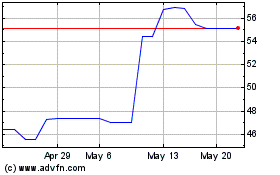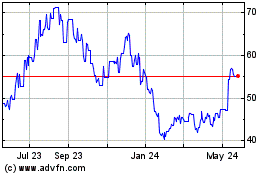Puma First-Quarter Profit Rises on Strong Footwear Sales -- Update
29 April 2016 - 7:09PM
Dow Jones News
By Ellen Emmerentze Jervell
FRANKFURT-- Puma SE said Friday its first-quarter profit rose
4%, boosted by strong footwear sales.
The German sporting goods firm, a division of Kering SA, said
net profit was EUR25.8 million ($28.3 million) in the first three
months of the year, up from EUR24.8 million a year earlier. Sales
rose 7.3% when adjusted for currency effects, to EUR852 million.
The company's footwear business was the main growth driver, with
sales increasing in the segment for the seventh quarter in a
row.
"The first quarter of 2016 developed as we expected," said Puma
Chief executive Bjørn Gulden. "Both in our own retail and with our
retail partners we see a continuous improvement."
The improved numbers are timely for Mr. Gulden, who has been
working on turning around Puma since he took the company helm in
2013.
In the early 2000s, Puma experienced tremendous growth in the
lifestyle and fashion segment. However, with trends shifting, its
sales tumbled. Mr. Gulden has worked to shift the company's focus
back to sports and performance, paying particular attention to
female consumers.
Some analysts said Puma's growth was largely a sign of a healthy
sporting goods industry as such, whereas others said it was the
company's focus on female training that was starting to show
results.
Puma in 2014 signed an endorsement and design deal with
Barbadian pop star Rihanna. The first collection, dubbed Fenty x
Puma, made its debut on New York Fashion Week earlier this
year.
NPD Group data earlier this year suggested that Rihanna was the
most marketable of all "big name celebrities". Her resonance with
consumers seems to have had an impact on Puma figures too, said NPD
analyst Matt Powell.
"Many celebrities take months to lift a brand, if at all. In the
case of Rihanna, the reaction was almost immediate," he added.
An earnings drawback for Puma was once again a negative impact
from currency exchange rates.
A year ago, Puma lowered its guidance for 2015 because of the
strong dollar against the euro. Like other sporting goods and
retail firms, Puma manufactures many of its products under U.S.
dollar contracts in Asia. Negative currency effects have hit Puma
particularly hard, because it has limited financial muscle and
can't afford to hedge all currencies.
On Friday, the company said it had raised prices and improved
its product mix and sourcing in a bid to offset the negative impact
from a stronger U.S. dollar.
Puma confirmed its outlook for the year.
Write to Ellen Emmerentze Jervell at ellen.jervell@wsj.com
(END) Dow Jones Newswires
April 29, 2016 04:54 ET (08:54 GMT)
Copyright (c) 2016 Dow Jones & Company, Inc.
Puma Ag Rudolf Dassl (PK) (USOTC:PMMAF)
Historical Stock Chart
From Dec 2024 to Jan 2025

Puma Ag Rudolf Dassl (PK) (USOTC:PMMAF)
Historical Stock Chart
From Jan 2024 to Jan 2025
